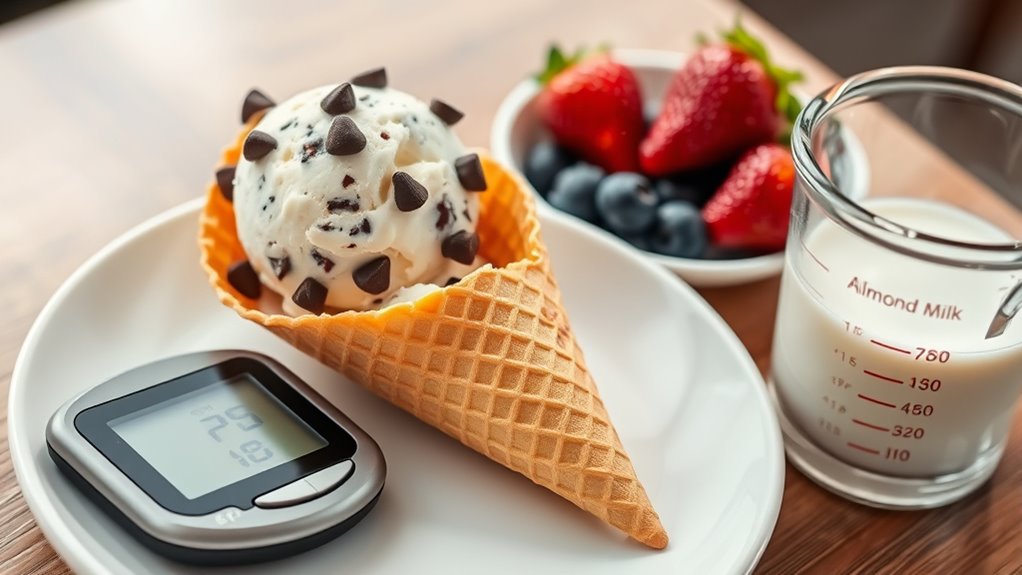Ice cream can be enjoyed by those with diabetes, but you need to choose wisely. Opt for brands with lower sugar content and alternative sweeteners like stevia. Keep portions under 30 grams of carbohydrates and pair your treat with protein-rich foods to stabilize blood sugar levels. Moderation is key, so limit enjoyment to twice a week. There’s more to learn about safe ice cream choices and integrating them into your diet for balanced indulgence.
Key Takeaways
- Choose ice creams with lower sugar content and alternative sweeteners like stevia to minimize blood sugar spikes.
- Opt for higher protein and lower-carb options, such as Halo Top or Yasso Frozen Greek Yogurt Bars.
- Maintain serving sizes under 30 grams of carbohydrates and enjoy ice cream no more than twice a week.
- Pair ice cream with protein-rich foods to slow sugar absorption and manage blood sugar levels effectively.
- Consult a dietitian for personalized advice on incorporating ice cream into your diabetes management plan.
Understanding Blood Sugar Levels and Ice Cream

When you enjoy ice cream, it’s essential to reflect on its impact on your blood sugar levels. Ice cream has a medium glycemic index of 57, meaning it can cause a moderate rise in blood sugar. The simple carbohydrates in ice cream break down quickly into glucose, which isn’t ideal if you’re managing diabetes. Notably, higher fat content can slow sugar absorption, potentially lessening the glycemic impact. However, commercially produced ice creams often contain more sugar and additives, raising their glycemic index.
To make better choices, consider homemade options where you control the ingredients, reducing sugar content. Including unique homemade fruit juice recipes can provide refreshing alternatives that are lower in sugar. Additionally, incorporating whole foods into your diet can significantly enhance your overall nutrition. Furthermore, many foods that are unprocessed, such as raw fruits and vegetables, can offer a wealth of nutrients that support balanced blood sugar levels. Opting for ingredients with lower glycemic index can help you create healthier desserts. Timing your ice cream consumption with meals or pairing it with protein and fiber can help stabilize your blood sugar, keeping spikes at bay. Including high fiber content in your diet can further aid in managing blood sugar levels effectively.
Choosing Diabetes-Friendly Ice Cream Options

Choosing the right ice cream can be enjoyable and safe for those managing diabetes, especially if you focus on specific brands and options.
Look for Halo Top, which offers low-sugar, high-protein varieties sweetened with stevia and erythritol.
Blue Bell No-Sugar Added provides a tasty alternative without the extra sugar.
Try Edy’s Slow Churned Ice Cream for lower-carb choices or Nick’s Cookies and Kräm, which has added fiber and no added sugars.
For a protein-packed snack, consider Yasso Frozen Greek Yogurt Bars.
Always check labels for carbohydrate and added sugar content, aiming for under 30 grams of carbs and 13 grams of sugar per serving.
Moderation is key, so enjoy your treats mindfully!
Nutritional Benefits of Ice Cream for Diabetics

Ice cream can offer several nutritional benefits for diabetics, making it a delightful treat rather than a forbidden indulgence.
It’s a good source of calcium, essential for bone health and improving insulin sensitivity. Many options contain probiotics that support gut health and aid digestion, which can be particularly helpful if you experience digestive issues. Additionally, it’s important to choose low-fat options to help manage overall calorie intake. Furthermore, the U.S. FDA defines ice cream as having a minimum of 10% milkfat, ensuring a certain level of richness that can be satisfying in moderation. Moreover, some studies suggest that coffee’s antioxidants may enhance the overall health benefits of ice cream when included as part of a balanced diet.
Incorporating sugar-free options can also help diabetics enjoy this treat without significantly impacting their blood sugar levels. Plus, ice cream provides protein that helps slow sugar absorption when paired with other protein-rich foods. Opting for varieties with natural ingredients and adding fruits or nuts can enhance the nutritional value further. Additionally, enjoying ice cream in moderation can help reduce stress and anxiety levels, making it a more enjoyable experience for diabetics.
Health Implications and Risks of Ice Cream Consumption

While indulging in ice cream might seem harmless, it’s vital to take into account the health implications and risks, especially for those managing diabetes. Ice cream’s simple carbohydrates can cause rapid blood sugar spikes, leading to fatigue and other issues. Additionally, the automation of data analysis speed can help in identifying dietary patterns that affect blood sugar levels. Furthermore, the high sugar content increases your risk of cardiovascular diseases, kidney damage, and even mood swings due to sugar crashes. Some ice creams contain alternative sweeteners that can result in digestive problems like bloating.
Interestingly, studies show that the majority of health risks associated with high sugar consumption can be linked to diabetes complications. Furthermore, consuming high-sugar foods regularly may interfere with the body’s ability to maintain blood flow for optimal health. Additionally, frequent consumption may heighten the risk of developing prediabetes or complications related to Polycystic Ovary Syndrome. It’s important to remember that a balanced diet combined with mindful eating can support better overall health. Remember, moderation is key, and managing your carbohydrate intake is essential when considering ice cream as part of your diet. Early detection of potential health issues can help in managing overall well-being.
Integrating Ice Cream Into a Diabetes Management Plan

For those managing diabetes, finding ways to enjoy treats like ice cream can be a delightful challenge. Start by choosing ice cream with lower sugar content and alternative sweeteners like stevia. Look for options that have higher protein and nutritional mix-ins, such as nuts, to help stabilize blood sugar levels. Essential oils can also be used for flavoring, but ensure they are safe for consumption. Keep your serving size under 30 grams of carbohydrates and monitor your overall intake throughout the day. Pair ice cream with protein-rich foods or enjoy it after a balanced meal to minimize spikes in blood sugar. Remember to check nutrition labels for added sugars and fiber content. Additionally, consuming ice cream with lower sugar content can help in managing blood sugar levels effectively. Incorporating chia seeds into your recipes can also enhance the nutritional profile of your treats, as they are a high omega-3 source that can provide additional health benefits. A juice cleanse can provide nutrient-rich ingredients that support overall wellness and may help in managing cravings. Consulting a dietitian can also help tailor your choices to fit your unique dietary needs while satisfying your sweet tooth.
Tips for Portion Control and Meal Timing

To effectively manage your enjoyment of ice cream, practicing portion control and timing your meals can make a significant difference in blood sugar management.
Start by measuring out servings—aim for about half a cup to keep carbohydrates in check. Use smaller bowls to visually limit portions, and track the carbohydrate content to guarantee you don’t exceed one carb choice per serving. Additionally, consider incorporating freshly squeezed juices into your diet as a healthier alternative to sugary drinks. Implementing real-time monitoring systems can also help you keep track of your overall dietary intake. Understanding color accuracy in food choices can also enhance your overall experience. It’s important to create a budget for your treat consumption to ensure you are mindful of your overall dietary choices.
Enjoy ice cream no more than twice a week. Pair it with meals or snacks and include protein sources to balance its effects. Avoid eating it alone to prevent rapid blood sugar spikes.
Finally, consider exercising after indulging to help mitigate its impact, ensuring your overall diet remains balanced for better diabetes management. Incorporating sustainable fashion practices in your lifestyle can also enhance your overall well-being.
The Role of Alternative Sweeteners in Ice Cream

Alternative sweeteners play an essential role in creating ice cream that’s both delicious and suitable for those managing diabetes. These alternatives, like stevia, monk fruit, and erythritol, greatly reduce sugar content without sacrificing taste. They don’t raise blood sugar levels, making them ideal for keeping your glucose stable.
Plus, ice creams made with these sweeteners generally have fewer carbohydrates and lower added sugar, which is vital for diabetes management. However, be aware that some sweeteners can cause digestive issues, such as bloating or gas.
Many people find the flavors of these alternatives acceptable, and with the growing market demand, you’ll discover an increasing variety of no-added-sugar options that cater to your health-conscious lifestyle.
Future Directions for Research and Dietary Guidelines

As researchers explore deeper into the relationship between ice cream and health, it’s vital to establish clear dietary guidelines that reflect these findings.
Current observational studies suggest a need for more randomized controlled trials to determine the true health impacts of ice cream. Future research should involve diverse populations and control for confounding variables to draw accurate conclusions.
While the American Diabetes Association recommends moderation and lower-sugar options, it’s important to understand that ice cream can fit into a balanced diet.
Public health messaging must emphasize moderation, avoiding sensational claims. As we learn more, developing guidelines that allow occasional treats without compromising health will be key to managing diabetes effectively while enjoying life’s little pleasures.
Frequently Asked Questions
Can I Eat Ice Cream Daily if I Have Diabetes?
You can enjoy ice cream daily, but moderation is key if you have diabetes. Aim for smaller portions and choose lower sugar options to manage blood sugar.
Pair your ice cream with protein to help stabilize levels, and consider making it at home to control ingredients.
Regularly monitor your blood sugar after enjoying it, and consult a dietitian to guarantee it fits into your overall diabetes management plan effectively.
How Does Ice Cream Affect Insulin Sensitivity?
Ice cream can greatly impact your insulin sensitivity. When you consume it, the high sugar and carbohydrate content causes blood sugar spikes, making insulin regulation more challenging.
Over time, this may worsen insulin resistance, especially if you eat it regularly. To mitigate these effects, focus on portion control, choose lower-sugar options, and consider pairing ice cream with protein.
Monitoring your blood sugar levels can also help you understand its effects on your body.
Is Dairy-Free Ice Cream Better for Diabetics?
Dairy-free ice cream isn’t necessarily better for diabetics. While it can offer lower glycaemic index options, many brands are higher in carbohydrates and calories.
You’ll need to check nutrition labels carefully, focusing on total carbs and sugars. Choosing options with agave syrup may help, but portion control is essential.
Homemade versions can give you better control over ingredients. Ultimately, it’s about balancing your choices to manage your diabetes effectively.
What Are the Best Toppings for Diabetic-Friendly Ice Cream?
When you’re looking for the best toppings for your ice cream, fresh fruits like berries and stone fruits are fantastic choices. They add natural sweetness and fiber, helping to stabilize your blood sugar.
You can also sprinkle on raw or dry-roasted nuts for a satisfying crunch and healthy fats. Consider sugar-free chocolate chips or sauces for a sweet kick without the added sugar.
Don’t forget to get creative with unsweetened coconut flakes or fresh herbs for added flavor!
Can Ice Cream Consumption Lead to Weight Gain for Diabetics?
Yes, ice cream consumption can lead to weight gain for you if you eat it frequently.
Its high calorie and sugar content can contribute to excess calories, especially if portion sizes aren’t controlled.
If you’re not mindful, those extra calories can add up quickly, resulting in weight gain.
It’s important to balance your indulgences with healthier choices and maintain an active lifestyle to manage your weight effectively.
Moderation is key!
Conclusion
Incorporating ice cream into your diet as a diabetic doesn’t have to be off-limits. By choosing diabetes-friendly options and practicing portion control, you can enjoy a sweet treat without compromising your health. Isn’t it great to know that you can still savor your favorite flavors? Remember to monitor your blood sugar levels and consider how ice cream fits into your overall meal plan. With the right choices, you can indulge responsibly while managing your diabetes effectively.










